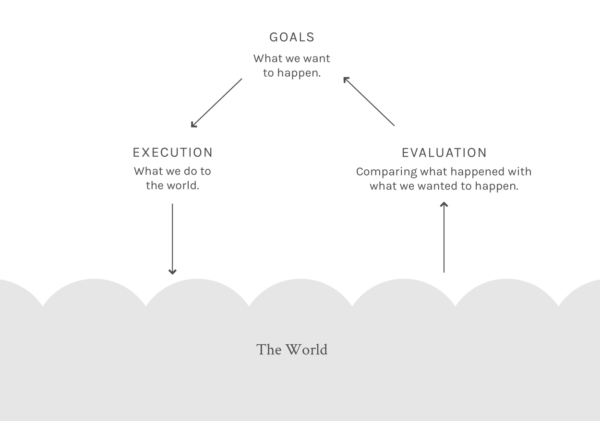The Design of Everyday Things • Don Norman • 1988
On the Gulf of Evaluation (Natural Mappings and Feedback)
In Short
The Gulf of Evaluation describes the potential issues that arise from the discrepancy between the current state of the system and the user’s perceptions of it. Designers can narrow the gap through the use of natural mapping and clear feedback.
In Depth
The way Norman models the cycle of human action focuses on a goal-oriented concept of cognition. Our interaction in the world flows through stages of evaluation of the world, forming goals based on that evaluation, and executing the intention of our goals on the world. Norman uses this model to point out sites for potential usability issues, which he calls “gulfs.”

The Gulf of Evaluation identifies the potential gap between the physical state of the world and our perception or interpretation of it. How do we know the current state of the system? How do we know our previous actions have changed the system in the desired fashion? Two of his concepts are particularly relevant here.
Natural Mapping
Natural mapping, by which I mean taking advantage of physical analogies and cultural standards, leads to immediate understanding. For example, a designer can use spatial analogy: to move an object up, move the control up. To control and array of lights, arrange the controls in the same pattern as the lights. Some natural mappings are cultural or biological, as in the universal standard that a rising level represents more, a diminishing level, less. (p.23)
Mapping is a key principle for Norman and affects both evaluation and execution of action. He advises designers to use “natural mappings” whenever possible to directly correlate the state of a system with how it looks so users can evaluate the situation quickly and accurately. A basic example: are the dials of your stove visually mapped in the same orientation as the burners they control?
The basic idea here is hard to disagree with. Arbitrary mappings make things harder to learn and use. But I’m not sure I would use the term “natural” to describe mapping choices, as all associations needed to be learned at some point. It seems like the better term would be “conventional” since what we really mean is aligning with shared conventions.
Feedback
A critical part of an action is the evaluation of its effects. This requires timely feedback of the results. The feedback must provide information that matches the user’s intentions and must be in a form that is easy to understand. (p.199)
The idea of feedback is straightforward enough to seem almost not worth mentioning. But that is probably why Norman’s book is a classic; it makes usability seem obvious and required for design.